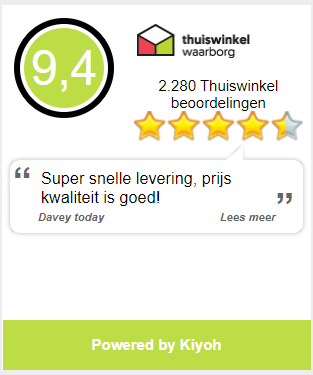Drones regels en wetgeving (update 2021)
After the entry into force of the upcoming European laws and regulations for drones was postponed in April of this year, we are now on the eve of the long-awaited introduction of the new drone rules. Until December 31, 2020, the distinction is mainly made between commercial and non-commercial use of drones, the upcoming drone legislation is based on the risk profile of a flight. The current ROC and ROC-Light will therefore disappear from the drone legislation and be replaced by the new rules.
Mandatory registration
Anyone who wants to fly after December 31 with a drone heavier than 250 grams, or with a camera, must register as a person or organization online with the RDW. After registration you will receive a unique identification number from the RDW which you must always visibly mount on the drone by means of, for example, a sticker. The unique identification number ends up in a European database so that you can access all over Europe
fly. Keep in mind that the operator registration is only possible in the country where you reside.
CE marks
Where in current legislation drones had to be registered in the aircraft register and in some cases had to be provided with an SBvL inspection, the new drones will be provided with a special drone CE mark. Based on, in particular, the weight of the drone, six different classes have been created from C0 to C6.
Three categories
The new drone rules are based on the risk profile of a flight. The distinction is characterized by three categories; Open category, Specific category and the Certified category.
Open category
The Open category is the category that includes flights characterized by the lowest risk profile. Almost all hobby pilots and current ROC-Light holders will end up in this Open category from 31 December. A number of general rules apply in the Open category. In addition, depending on the weight of the drone, a number of additional rules apply. These rules are linked to the three subcategories A1, A2 and A3.
General rules
European drone legislation relaxes the rules with regard to the maximum height and
distance. Compared to the current ROC-Light, the maximum height will be increased from 50
meters to 120 meters. As a pilot it is and remains mandatory to keep the drone in sight,
however, the maximum distance will lapse in the new legislation. It is further from the pilot
expects he or she to keep a safe distance from people and not over crowds
flies. In addition, a drone pilot always gives right of way to other air traffic and is allowed
there are no flights in the indicated no-fly zones.
Subcategory A1
This subcategory includes drones with a CE mark of C0 (up to 250 grams) or C1 (up to 900
grams). Pending these CE markings, it is allowed to use
current drones up to 500 grams to fly in subcategory A1. This subcategory becomes
classified as very low risk, it is therefore allowed to over people (no crowd)
to fly.
Subcategory A2
This sub-category is classified as the sub-category with the highest risk profile.
Drones with a CE mark C2 (up to 4 kilograms) fall into subcategory A2. With this type
drone you should keep at least 30 meters away from people unless you fly slower
than 3 m / s, the distance may be shortened to 5 meters. Also fall into this subcategory
the current drones without CE mark from 500 grams to 2 kilograms, but you should instead
of 30 meters to keep 50 meters away from people.
Subcategory A3
Sub-category A3 has the same risk rating as sub-category A1, namely a low
risk profile. In this subcategory you must keep a distance of at least 150 meters
buildings, industry and recreational areas. The distance to people should be equal to
flight altitude where 30 meters is the minimum distance. In this subcategory you can fly with
drones with CE mark C2 (up to 4 kilograms), C3 / C4 (up to 25 kilograms). Also the current drones
without CE mark from 2 kilograms to 25 kilograms fall into this subcategory.
The European Drone Certificate
To fly as a pilot in the Open category, it is mandatory to be recognized in Europe
Get drone proof. For subcategories A1 and A3 you need an (online) training
and take the theory exam. If you want to fly in subcategory A2, here comes one
additional theoriege part + exam and you also submit a self-declaration regarding
to submit to practice. After completing the training you request the official European
recognized Drone Certificate at the RDW.
DronePilot Basic Light
The DronePilot Basic Light training is the training that leads to the European Drone Certificate for
subcategory A1 / A3. The training is online and consists of 9 subjects such as
air traffic safety, flight principles, privacy and insurance. The subjects
are supported by videos and images. The training is
concluded with an online theory exam of 40 questions of which you pass at least 30 questions
must answer to apply for your official European recognized drone certificate at the RDW,
it remains valid for five years.
DronePilot Basic
The DronePilot Basic training is the training that leads to the European Drone Certificate for
subcategory A1 / A2 / A3. The training is online and consists of 11 subjects such as
for example air traffic safety, flight principles, privacy, insurance,
meteorology and operational procedures. The topics are supported by
through videos and images. The training is concluded with an online theory exam
of 40 questions of which you must answer at least 30 questions correctly and one
additional theory exam of 30 questions. In addition to these two certificates, you also need to join the
application for the European recognized drone certificates at the RDW to declare that you have the
completed practical self-training.
Specific-category
If the flight's risk profile falls outside the framework of the Open category, the flight falls
within the Specific category. You have permission to fly in this category
required from the ILT (Inspection, Living Environment and Transport). It is possible in three ways to
to get permission:
1. Submitting a claim according to a Standard Scenario (STS)
2. Getting a permit for a particular type of flight by submitting
a Specific Operations Risk Analysis (SORA)
3. Obtaining a Light UAS Operator Certificate (LUC)
These three options apply to the operators. The pilot must have a theoretical knowledge
practical diploma issued by a recognized training institute. The content of the theory
depends on the required knowledge according to the Standard Scenario.
Certified category
In the Certified category, flights that fall outside the limits of the Specific category
fall. These are flights with unmanned aerial vehicles larger than three meters
over crowds, or flights in which people or dangerous goods become
transported. The requirements for flying in the Certified category are similar to those
of manned aviation.
Transitional arrangement
From December 31, the current drone rules will expire and the new EU rules will come into effect
to go. After 31 December, you as a current certificate holder have one year to convert it
convert to the European variant. It is important, however, that all certificate holders agree to 31
December register with the RDW as an operator, from this moment the ILT will register all previous PH registrations
Undo.
No posts found
Write a review


